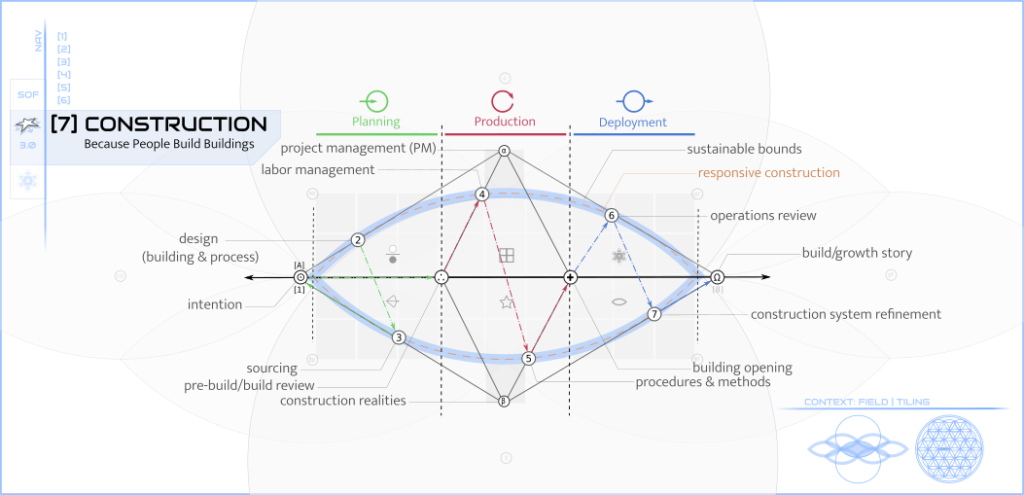
[7] Construction
Construction is a adaptation of the [7] The Seven Steps of Project Management (PM) applied to the field of Construction Management. Construction outlines the process of Construction Management with the intent of developing and executing integral, sustainable building projects. Both this frame and The Seven Steps are versions of [7] The Mandorla frame, the seventh systems shape of the Semantic Ontology Framework (SOF).
Values and Virtues
As a fundamentally human enterprise, construction should be governed by [3] The Three Powers.
- Maximize how many stakeholders contribute to project.
- Promote creativity of all involved people
- Express identity of the people in both design and sourcing
Examples
Planning: [belongs?] what if we keep an eye for sources (vendors/products) where people express themselves? This is an opportunity to connect to humanity of source-people in a deeper way. Enriches process and often makes people into advocates who are willing to unlock additional resources. Did something like this happen? Roof metal? Definitely craftsmanship of project. Dennis S. and milling (enabled by using our wood).
Connects to Source section of ATRALA. [Probably belongs below]
Progression
Like all projects built using the [7] The Mandorla frame, Construction has three phases, each focused on a particular kind of system motion: Source, Cycle, Drive. These phases are broken into seven steps and three transitions.

Planning Phase (Source)
Step 1: Intention
Intention is the Prime of a construction system. A prime is a central organizing principle which holds a whole system together with its gravity, thus unifying all the other systems that feed into construction, all the systems that work within the construction process, and all the systems the construction process impacts. It is also the purpose the system is trying to accomplish. This makes “Defining Your Intention,” as this step is called in [7] The Seven Steps, critically important. If in the course of construction, you accomplish something you did not intend or you fail to accomplish something you set out to do, the overall process may be painful and may have negative or even disastrous effects on the people involved.
For example, over 10% of couples will consider divorce while renovating their homes.1 If improving your physical home ruins you relational one, what was the point? But if you can keep in focus the intention of a renovation at every stage — like increasing the spaces where your family wants to be around each other — then it will be easier to control yourself and the process because you will be centered on that intention, weaving it into every step of the process.
- The purpose of something must be greater than its use. While a building might hold the rain off of your head, who would want to live in a house constructed with only that idea in mind? A building, like any thing, must exist to reference a purpose larger than itself. Buildings, like all things, are used by people to accomplish something in their lives. What will the people in this building want to accomplish? Add up the totality of those things and find the highest and most unifying of these: that’s your buildings true purpose. Things designed only for use are generally poor in quality, destructive in fabrication, and easily disposable — things we all should want less of, especially important when considering the cost and size of buildings.
Example: Tent of Meeting — use. But relates to Moses meeting with God face-to-face, the center of his friendship. This idea of the tent as context for revelation/divine communication on a more practical level: Numbers 9 hints at greater purpose that fulfills the meeting idea – presence of God, which also served as means of communication of the will of God based on the movements of the cloud.
Step 2: Design (Building & Process)
Step 3: Sourcing
Transition: Pre-Build/Build Review
Production Phase (Cycle)
Step 4: Labor Management
Step 5: Procedures & Methods
Transition: Building Opening
Deployment Phase (Drive)
Step 6: Operations Review
Step 7: Construction System Refinement
Transition: Build/Growth Story
Media
Related Entries
References & Notes
- John Patrick Pullen, “Renovating a house can be such a nightmare that it leads over 10% of couples to consider divorce” Business Insider. Nov 14, 2017. https://www.businessinsider.com/12-of-couples-consider-divorce-when-they-are-remodeling-their-home-2017-11

